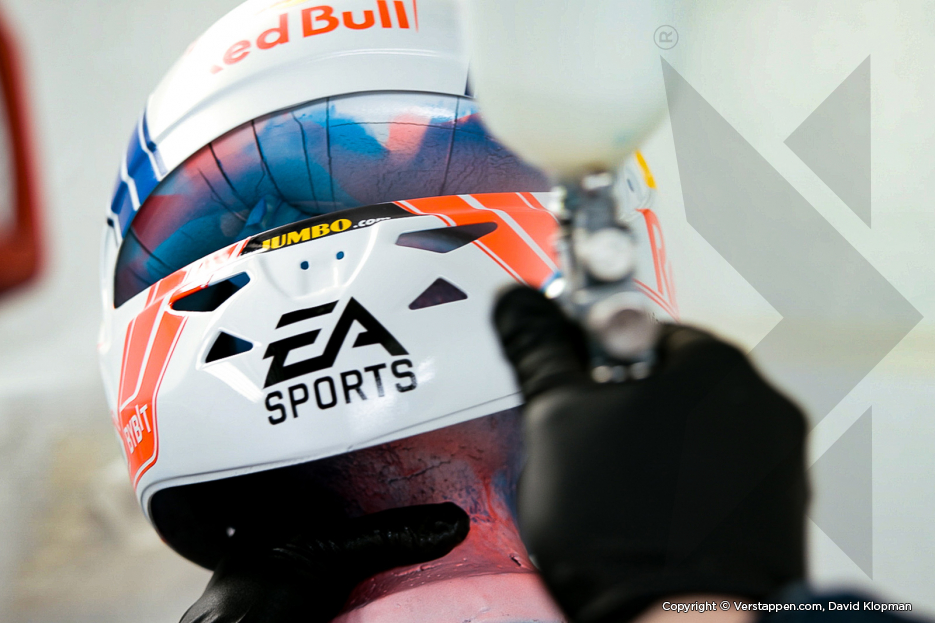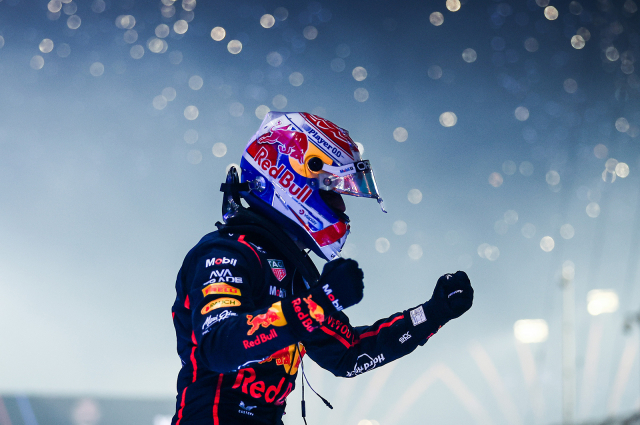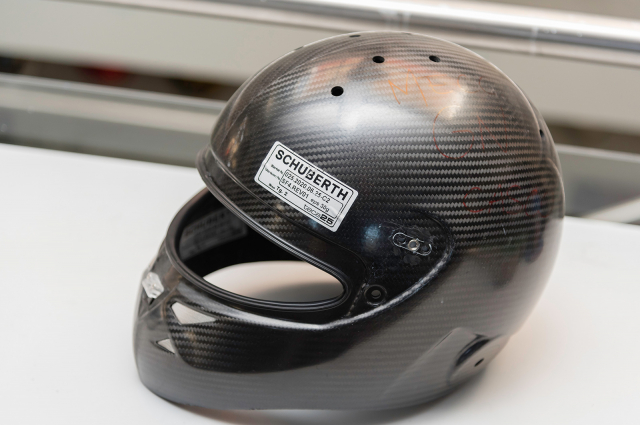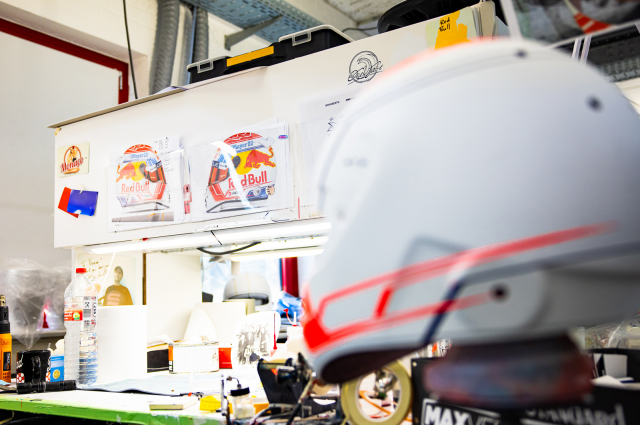Exclusive sneak peek into painting Max' helmet: 'Very important to me'
Published on 28 February 2023 by Heidi De Love
The new Formula 1 season is upon us, and like every year Max Verstappen has a brand-new helmet with a new colour scheme. There’s a lot involved in making the helmet. Verstappen.com enjoyed a unique behind the scenes look at Jens Munser Design, the helm painter of Max Verstappen.
Since the very beginning of his Formula 1 career Max Verstappen wears helmets painted by Jens Munser Design. At the entrance of the factory, located near Salzgitter in Germany, a massive collection of Formula 1 helmets is on display. The experienced helmet painter has been making beautiful helmets for years for numerous Formula 1 drivers such as champions Michael Schumacher, Sebastien Vettel as well as Max Verstappen.
Jens Munser started his career as helmet painter in the 90’s in the motocross scene. What started out as hobby quickly grew into a full-time job when he entered motorsport. In 2000 he hooked his biggest client, Michael Schumacher. “His helmet manufacturer, Schuberth, asked me in 2000 to make the helmets for Michael and that marked the end of my little company”, explains Jens. “Before that it was a one-man show but now, I had to become professional and hire people. I worked through many nights to deliver on time. Sebastian Vettel was our biggest customer up until last year. This year we make helmets for seven Formula 1 drivers.”
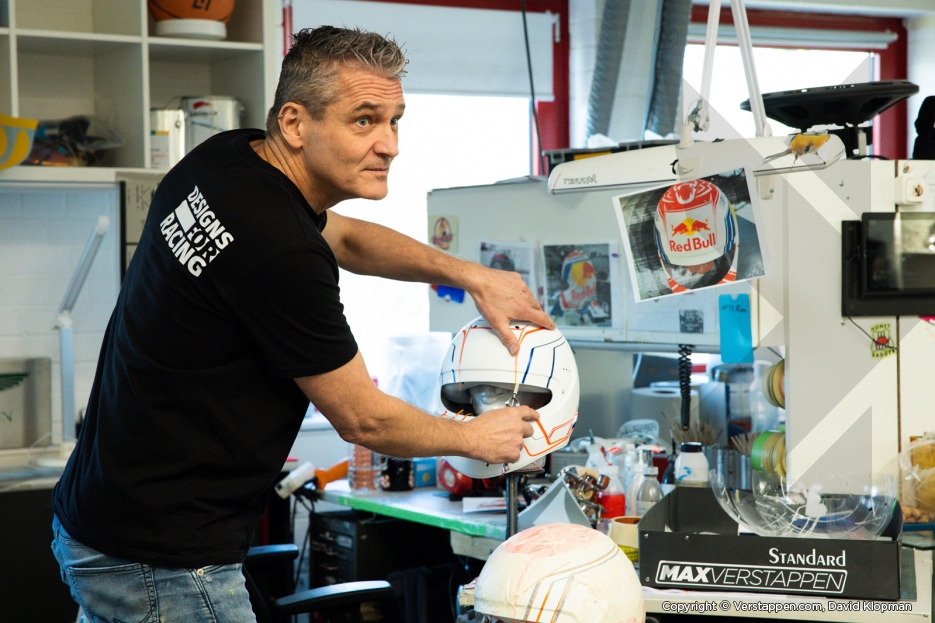 Max has been driving in helmets painted by Jens Munser Designs during his entire F1 career. This relationship even started during Max' time in Formula 3, explains Jens: “It started when Max became junior driver for Red Bull in 2014. They told me they had a new driver and I recognized the name of his father. We do a lot for the junior drivers and that’s how we started our relationship with Max.”
Max has been driving in helmets painted by Jens Munser Designs during his entire F1 career. This relationship even started during Max' time in Formula 3, explains Jens: “It started when Max became junior driver for Red Bull in 2014. They told me they had a new driver and I recognized the name of his father. We do a lot for the junior drivers and that’s how we started our relationship with Max.”
“Helmet design is very important to me, it represents your identity as a driver”, says Max. “Throughout the years it has become harder to see the entire helmet when you’re in the car due to the safety constructions around the cockpit. But I find it important to spend time on it and to make the helmet design as personal as possible.”
Jens takes us through the process of painting a helmet for Max from start to finish. Firstly, Schuberth, the helmet manufacturer, delivers a black carbon-shell. On this a coat of silver paint is sprayed, followed by applying a coat of white paint to obtain a white base colour. “The reason for the initial silver coat is that this covers the black much better”, explains Jens. “If you only spray white on a black helmet, you have to apply three coats of white before it is fully covered.”
Once the base coat is dry, the lines where the sponsor logos will be are marked in pencil. Transferring the design from drawing to helmet is the most complex part of the process according to Jens, as you are changing from a 2D drawing to a 3D surface: “We tried to do this with a projector or laser machine but given the many types and sizes of helmets this proved impossible. We work with a plastic mold around the helmet with holes in it to apply the pencil markings, this method dates back to when we made Schumacher's helmets. This works perfectly to ensure that the design is conveyed as accurately as possible and that two helmets are also exactly alike.”
After applying the pencil markings, the parts of the helmet that should stay paint free are covered with tape. Some lines are applied directly with decals as this is more accurate than spraying. The distinctive lion on the top of Max's helmet is also covered by a decal. The white background that remains covered by the sticker eventually forms the lion, while the rest around it is painted red.
The first colour sprayed on the white helmet is fluorescent red. After spraying in the spray booth, the helmet goes into a drying oven for one minute before one more coat of fluorescent red is applied. Once this has dried, the helmet is taped off again to cover all parts that should not turn blue. After this, the blue metallic paint is also applied to the helmet.
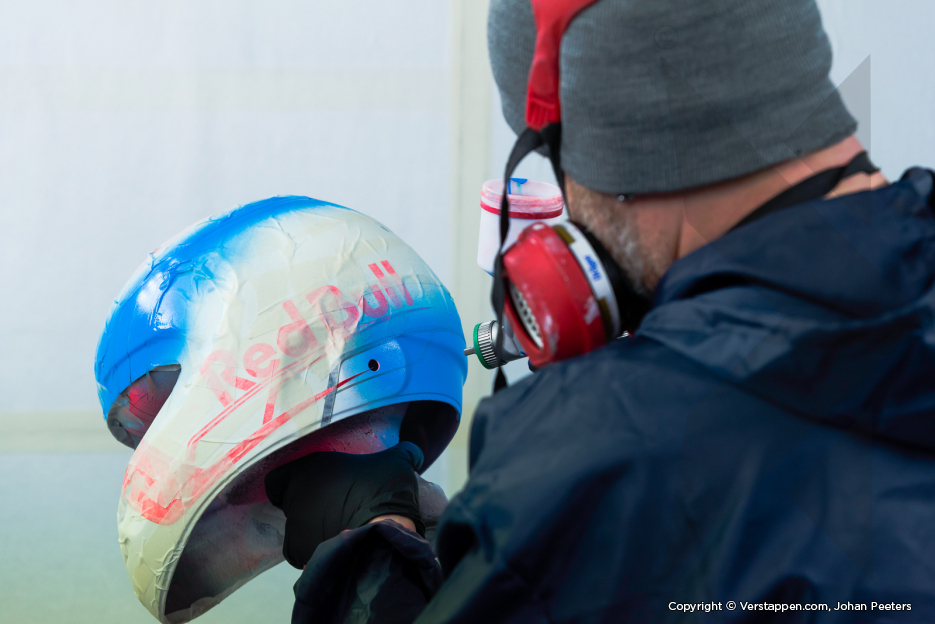 After the spraying of the colours the sponsor logos are applied with the utmost precision. Again, the pencil marks help to place the logos in exactly the right place. A precision knife is used to remove the sticker residue and an eraser is used to wipe away the pencil marks. A clear coat, overnight drying, followed by a final clear coat provide the finishing touches. The helmet is now ready to be shipped to Schuberth, where the helmet lining and other attributes are attached to the helmet. Also, that very first helmet serves as an example for the 1:2 and 1:4 scale models, which Schuberth produces exclusively for Verstappen.com.
After the spraying of the colours the sponsor logos are applied with the utmost precision. Again, the pencil marks help to place the logos in exactly the right place. A precision knife is used to remove the sticker residue and an eraser is used to wipe away the pencil marks. A clear coat, overnight drying, followed by a final clear coat provide the finishing touches. The helmet is now ready to be shipped to Schuberth, where the helmet lining and other attributes are attached to the helmet. Also, that very first helmet serves as an example for the 1:2 and 1:4 scale models, which Schuberth produces exclusively for Verstappen.com.
The cooperation with Verstappen is smooth sailing according to Jens: “I receive the design from the management of Max. During the painting I show Max the colours, the effects and special ideas. We meet each other regularly on the track, send photos and check everything with Raymond Vermeulen but the final decision is always taken by Max. If he says no, it’s not happening. Ultimately he’s the customer who has to wear the helmet. After so many years of experience though, I know what Max wants and what he finds important. That’s the lines on the chin and the V shape of Verstappen. Everything else changes every year but the lines on the chin have never changed and are very important to him.”
Since 2019, Max started using a white background for his helmet. Jens was immediately in favour of this: “It was his wish to change to a white background and I really love white helmets. White is clean and the colours stand out better. The combination Max has of white and fluorescent red in a blue car is a great combination, just like last year with the gold in the helmet.”
About his new helmet design for this year Max says: “The colours with the red and blue are a little different compared to last year. I have also chosen a more old-school design, with small lines and no glitter. A little bit “back to the roots”. Also the back of the helmet is more tight and cleaner. I like the new colours. The helmet looks good and I’m happy with the design.”
 Jens can only confirm what Max says: “This year Max has a simpler design and to me it only looks better. I like it that Max returned to the colours of his home country. Maybe I’m getting a little older but these days the designs of some drivers are too busy and it feels like five designs in one. I love effects, flakes and chrome but not too many elements in one helmet.”
Jens can only confirm what Max says: “This year Max has a simpler design and to me it only looks better. I like it that Max returned to the colours of his home country. Maybe I’m getting a little older but these days the designs of some drivers are too busy and it feels like five designs in one. I love effects, flakes and chrome but not too many elements in one helmet.”
Choosing his favorite helmet he made for Max, Jens is clear: “I think the golden helmet after his championship last year is very beautiful, with the gold leaf. I love gold leaf because it’s natural. The effects of the lines match very well. It looked amazing under the artificial light in Abu Dhabi.”
The fact that in Max, he has yet another world champion as a customer makes Jens very proud: “We made helmets for Michael Schumacher, for Sebastian Vettel and now for Max. The story continues and of course we are very proud. It’s good that Max is still young and I hope he will drive Formula 1 for many years to come.”
All helmets worn by Max are produced for Verstappen.com in 1:2 and 1:4 scale models. An excellent move according to Jens: “It’s good for the fans. It’s their only chance to buy a helmet as a true scale helmet is too expensive or not available. A helmet is the only part by which you can properly identify a driver and as such the only personal part of the driver.”

